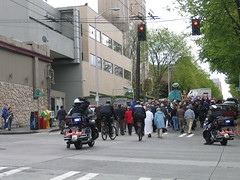 As we were on our way back up the hill after running an errand downtown today, Prairie and I noticed a procession leaving Town Hall. There was a large icon-type puppet figure towards the back, an angel figure towards the front, and quite a few children in acolyte’s robes, so we figured that it was religious in nature, but didn’t know much more than that. Prairie noticed a gentleman standing near us wearing a priest’s collar and asked him what was going on.
As we were on our way back up the hill after running an errand downtown today, Prairie and I noticed a procession leaving Town Hall. There was a large icon-type puppet figure towards the back, an angel figure towards the front, and quite a few children in acolyte’s robes, so we figured that it was religious in nature, but didn’t know much more than that. Prairie noticed a gentleman standing near us wearing a priest’s collar and asked him what was going on.
As it turns out, we’d stumbled into the celebrations surrounding the return of a 15th century altar painting by Renaissance artist Neri di Bicci to St. James Cathedral after restoration work. This piqued our interest, so we followed along up to the cathedral to watch the pageant and blessing service.
 While there, we found out that there’s something of a mystery surrounding this work of art — namely, how it got to St. James Cathedral in the first place.
While there, we found out that there’s something of a mystery surrounding this work of art — namely, how it got to St. James Cathedral in the first place.
But the big question surrounding the Renaissance work remains unanswered: How did this 15th-century altar painting by Florentine artist Neri di Bicci end up in St. James’ basement? Did a parishioner buy it? Was it an anonymous gift?
Art historians, church administrators and amateur sleuths have all taken their shots at solving the puzzle, but none has succeeded.
[…]
Church officials didn’t know they had a museum-quality piece until 1991. Then, an architect weighing a bid for work at the church asked a friend, Elizabeth Darrow, to take a look at it.
Darrow, then a UW art graduate student who had studied Renaissance art in Florence, was stunned when she saw the regal young Virgin sitting on a monumental throne.
“This is the most important Renaissance artwork in the Northwest — and the largest,” said Darrow, now a guest scholar at the J. Paul Getty Museum in Los Angeles.
Darrow believes it is among the most exquisite and detailed works of the Virgin Mary by the prolific di Bicci.
“The colors are very intense and vibrant,” she said.
“Her face is round, with rosy, translucent skin and refined features: straight nose, delicately arched eyebrows,” she said. “It’s very beautiful.”
[…]
Art scholars suspect the painting hung in an Italian church for most of its existence and was probably sold in the 19th century when the market for Renaissance artwork began. When it was found at St. James, it was in a 19th-century frame, Dorman said.
How it ended up at a Seattle church is less clear.
“It’s a great mystery,” said Darrow, who has gone so far as to track down wealthy local Catholic families for clues. She still has not given up hope of solving the puzzle; she’s even enlisted the help of art scholars in Florence.
St. James administrators have searched all their archives at the cathedral and the archdiocese, “and there is no record, no bill of sale, no letter,” Ryan said.
Church officials heard there was an art dealer or collector who moved a few di Bicci paintings to the United States — mostly to the Midwest — during the 1920s and 1930s, but it is unknown whether the St. James Madonna was among them.
Church administrators have tracked down congregation members and workers from the 1950s. The best they can tell is that someone, perhaps an architect, found the painting in a crate in the lower level of the cathedral during a major renovation in 1950.
Really a fascinating little piece of local art history to stumble across on an otherwise quiet Sunday afternoon. The painting was still partially under wraps for today’s ceremonies, but it will be hung this week and formally dedicated during next Sunday’s 4pm vespers service.
More photos can, as usual, be found in a Flickr photoset.
